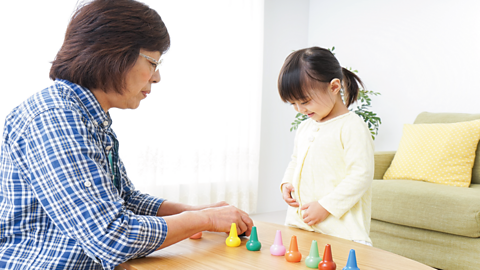Subitising sounds technical and itâs unlikely you came across it when you were at school. Early Years expert Helen Hickson explores what subitising is and how you can help your child practise at home.
At its simplest, subitising is being able to visually see a number of objects instantly without needing to count them out one at a time.
Subitising actually comes from the Latin word for suddenly; it may not be a word we hear very often but itâs actually a crucial skill that many of us use on a daily basis without even realising it.
Have you ever played a board game with your child and noticed that they are able to tell you how many dots are on the die without needing to count? Thatâs subitising.

In the same way, children who love to watch Numberblocks soon become aware that certain arrangements of blocks are a particular amount â or character.
In schools, teachers use different number patterns and games to support childrenâs understanding of numbers and help them recognize how âmanyâ each arrangement is without the need to count.
Why is subitising important?
Subitising helps children to see, solve, and manipulate numbers in their head.
This develops their number sense and helps them master key calculation strategies at an early stage.
Often young children learn to count but donât fully understand the relationship between numbers and amounts.

Different kinds of subitising
There are two different types of subitising. The first is perceptual. This is where children see an amount instantly. For instance, if you were watching two ducks swimming in a pond you would be able to see there were two just by looking at them.
Once theyâve grasped peceptual subitising, they can move onto a higher level skill: conceptual subitising. This is where children see larger patterns and can break down the amount into smaller groups using mental maths strategies.
For instance, if there were 6 ducks swimming, you might subitise by splitting the group up into two smaller groups of 3, or even 3 groups of 2. Through subitising, children can take on basic maths concepts such as odd and even numbers and number bonds.
Often children memorise numbers but donât always fully understand the relationship between numbers and amounts. Itâs a tough concept to grasp but subitising helps them connect the mathematical dots, which will help them in their Early Years learning.

How to practise subitising with your child
To help your child get comfortable with subitising up to 5, you can start off by using your hands. Sing songs, play games and encourage them to visualise the numbers instead of counting out loud.
In fact, you can practise subitising with anything you have around the house by arranging objects into different patterns. It helps to use items that your child enjoys â it might be their favourite toys. Like a lot of Early Years maths, itâs best learned through playing, experiment and exploring.
You might begin by using different coloured toy bricks. You could start by asking your child questions about the items to let them lead the exploration: can you see 3 bricks? Can you also see 2 blue bricks and 1 red brick?
Can they instantly tell you how many bricks there are? Or do they revert back to counting to check? Donât worry if they struggle at first. Itâs a hard concept to grasp and might take a bit of joint exploration.

Once they can confidently tell you whether there are 1 or 2 bricks without counting, introduce 4 and 5 and arrange the bricks in different ways to give your child the opportunity to see and say how many items there are.
Donât forget, when youâre subitising, there isnât any counting involved. Itâs about seeing amounts without the need to count.
Once theyâve mastered this crucial skill, theyâll be well on the way to becoming mathematical whizzes.
Subitising games and activities
Board games, especially when using dice, are another brilliant way of helping children to subitise and recognize key mathematical patterns.
Play a game of rolling a die and see how quickly you can say the number without needing to count any dots. Once children are familiar with the arrangement of dots you could put stickers over the faces of the die and create your own dot patterns together.

Some children will relate much better to real life objects than dot patterns. Ask your child to fetch two of their favourite toys and then arrange them in the familiar dice pattern.
Can they tell you how many there are without counting? Ask them to close their eyes and then rearrange the pattern or take one away, leaving just one toy.
Subitsing can take a bit of practice but mastering these mathematical skills at this early stage will help succeed later both in maths and across the wider curriculum.
Play Bud's Number Garden game. game
Practise recognising numbers, counting, ordering and sequencing numbers

More on Parent support - Maths
Find out more by working through a topic
- count3 of 3

- count1 of 3
